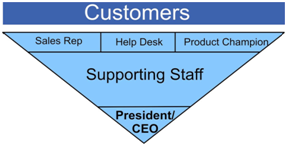Inverted Pyramid:
The traditional business is styled within form of a pyramid along with the chief executive officer at the top, senior executives underneath, and many more. There are several layers in the management structure, that reflects who reports to whom. In the inverted management pyramid display in figure, customers have the most significant role in driving the business. It also provides the front line employees a same ability as they are closest to the customers. Because the customers are considered basic, it also helps to improve the business. A flow of communication from the customers and inside the enterprise improves vastly. At one the inverted pyramid idea is accepted, a role of management requires undergoing a change: From a commanding role, it shall become a supporting one.

Figure: Inverted Pyramid
Table: Advantages and Disadvantages of Inverted Pyramid Structure
|
Advantages
|
1. In this structure the customers are given the first preference.
This way it becomes very simple to know their preferences and plan the strategies of the organisation accordingly.
2. Front line employees are given more responsibility and authority in the organisation than the top management because they are closest to the customers.
3. Decentralization of authority and responsibility place a very important role in prompt and timely decisions.
4. The inverted pyramid structure motivates the employees as they are placed in a better position than the top management.
|
|
Disadvantages
|
1. This structure may be dangerous because the role of top management is shifted to supporting one from that of commanding one which ultimately leads to the direction less- organisation.
2. In this structure there is absence of clear authority and responsibility levels as a result of which people become confused and business veers out of control.
3. Frontline supervisor cannot make strategies regarding organisations even though they have proper understanding of the customers because they are not equipped to do so.
|